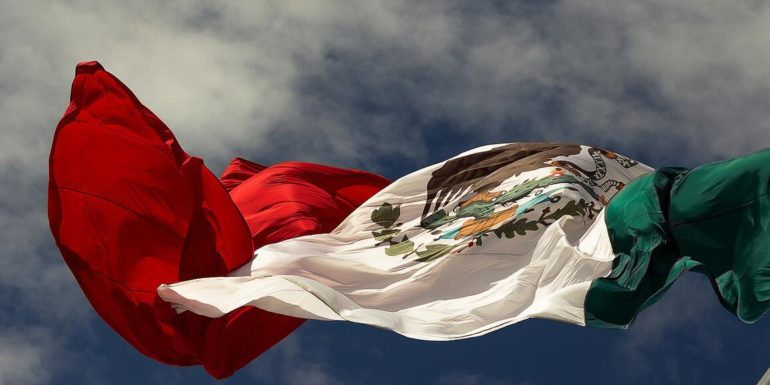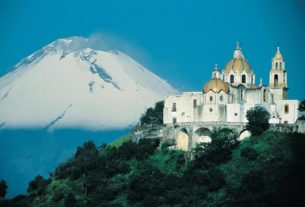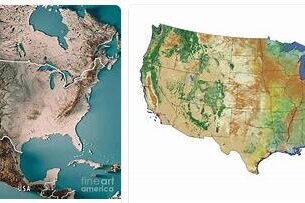Mexico is a federal republic in southern North America. Mexico borders north to the United States, east to the Gulf of Mexico, southeast to the Caribbean, south to Belize and Guatemala, and southwest and west to the Pacific. Mexico also includes several small island groups, including the uninhabited Islas Revilla Gigedo (830 km²), Islas Tres Marías (263 km²) and Isla de Guadalupe (264 km²) in the Pacific and the islands of Cozumel (490 km²) and Mujeres (3 km²) off the coast of Yucatán.
Mexico is the northernmost and third largest country in Latin America. The country was a Spanish colony from the 16th century until it became independent in 1821. There are major social and economic differences between population groups and regions. Parts of Mexico are haunted by serious crime and violence. The capital of Mexico City is the second largest city in the Western Hemisphere.
A common interpretation of Mexico (the name) is ‘the place where Mexitli (the war god of Mexicans or Aztecs ) lives’.
Geography and environment
Except for a narrow coastal plain on the Gulf of Mexico and lowlands of the Yucatán Peninsula, about three-quarters of the country is highland. Mexico City (Ciudad de México) is approximately 2500 meters above sea level. High Altiplanicia Méxicana is surrounded by the Sierra Madre Occidental mountain ranges in the west and the Sierra Madre Oriental in the east. They meet south of Mexico City and continue as the Sierra Volcanica Transversal volcanic mountain range with Mexico’s highest mountain Citlaltépetl (Pico de Orizaba) at 5700 meters above sea level. It is a north-south mountain range on the California Peninsula. Earthquakes and volcanic eruptions occur.
The highlands descend steeply towards coastal plains in the east and west. Along the Gulf of Mexico, lowland stretches 300 kilometers from Santiago in the north to the Yucatán Peninsula in the south. The lowlands here consist of swamps and lagoons as well as rainforests and savannas.
The Revillagigedo Islands (158 km²) in the Pacific belong to Mexico.
The country’s longest watercourse, the 3034-kilometer Rio Grande (Rio Bravo del Norte), is a border river to the United States. The 1100 km² Chapala Lake is the largest lake.
The climate is tropical and subtropical in the lowlands and temperate in the highlands. Varied topography and extensive north-south extensions give the country several types of climate. These are divided into four altitude zones: Tierra caliente (‘the warm land’) from 0 to 800 meters above sea level with daytime temperatures around 20-30 ° C, Tierra templada (‘the temperate land’) 800-100 meters above sea level and daytime temperatures of 15 –25 ° C, Tierra free (‘the cold land’) 1900–3500 meters above sea level and daytime temperatures of 10–20 ° C and Tierra helada (‘the frozen land’) in the highest mountainous areas where temperatures are below 10 ° C throughout year.
The areas in the north are dry with less than 100 millimeters of precipitation a year in some places. Most of the highlands and the Pacific coast have seasonal rainfall, most in May – October. The eastern and southeastern regions have 1000–4000 millimeters of rainfall per year and tropical hurricanes in July – October.
Mexico has a rich and varied vegetation. In the northwest, northeast and the inner highlands there are semi-desert and steppe with such as agave, yucca and cactus. On the southeast coast there is tropical rainforest and savanna, while higher-lying areas have forests with oak species and coniferous trees, among others.
The Tree of Hope remains strong (1946). Frida Kahlo painted this self-portrait for his friend Eduardo Morillo Safa after a surgery in New York. The title comes from one of her favorite songs and is written on the flag she holds in her right hand.
Wildlife is characterized by both North American species such as cougars, lynx, wolves, deer and foxes, and South American species such as monkeys, jaguars, tapirs, condors, sloths and game animals. There are many lizard and snake species. Coral reefs are found at the Yucatán Peninsula.
People and society
Mexico is Latin America’s second most populous state. No statistics are collected on ethnic groups in Mexico, but it is estimated that mastics make up about 62 percent of the population, while about 28 percent have predominantly or completely indigenous peoples. The remaining ten percent of the population is mostly European (CIA World Factbook 2012). Around 79 percent of the population lives in cities (2015), and Mexico City has over 21 million inhabitants (2018). According to countryaah, life expectancy at birth is 79.2 years for women and 73.5 years for men (2018).
Around 93 percent of the population speak only Spanish, while close to six percent speak Spanish and one indigenous language.
82.7 percent of the population goes to the Catholic Church. Protestants make up about six percent. Several indigenous groups have a syncretistic religion with features of Catholic religion associated with traditional religions.
State and politics
Mexico is a federal republic. A president, who is elected for six years and cannot be re-elected, is both the head of state and government and has the executive power. The President himself appoints the government. The National Congress consists of the Chamber of Deputies with 500 members and the Senate with 128 members. Congress is elected for three years, the Senate for six.
Mexico is divided into 31 states and one city. Each state has an elected governor and a legislative assembly.
First-time military service is twelve months and is covered partly by voluntary recruitment and partly by selective selection. In addition to forces in the Army, Navy and Air Force, there are reserves and a semi-military force.
Mexico is a member of the UN and most of the UN’s special organizations, including the World Trade Organization. The country participates in, among others, the OAS (Organization of American States) and NAFTA (the North American Free Trade Agreement).
History
In pre-Columbian times, Mexico had several indigenous communities at high cultural levels: the Olmec culture from about 1200 to 400 before our time (BCE), the Zapotec culture from about 500 BCE. to 900 according to our time (possibly), the Mayan culture from about 300 to 1524 AD, the interpreting culture from about 900 to 1250 and the Aztec culture from about 1345 to 1521.
In 1521, Hernán Cortés and his small Spanish army destroyed the Aztec capital Tenochtitlán and built Mexico City on the ruins. Indigenous people worked as slaves in the silver and gold mines, and the church and the nobility dominated agriculture from large estates; haciendas.
In 1824, three years after independence, Mexico became a federal republic. The war against the United States in 1846–1847 ended with defeat. At the peace in 1848, Mexico surrendered both California and Texas and sold the land in between to the United States.
From 1864 to 1867, Mexico’s empire was under French protection. Industrialization and modernization under General Porfirio Diaz from 1877 to 1911 brought economic growth. In the period 1911-1920 there were civil wars. In the 1930s a land reform was implemented and in 1938 the oil companies were nationalized.
After 1945, industrialization continued without social policy being followed up, and prosperity ceased. A nationalist government sought to limit dependency on the United States. In the 1970s improved large oil discovery in the Gulf state’s economic base, but poor management of the revenues brought the country close to bankruptcy.
In 1968, Mexico City hosted the Summer Olympics. In 1985, the capital was hit by a powerful earthquake. In 1994, when the economic crisis was under way again, the NAFTA Free Trade Agreement with the United States and Canada entered into force. In the 1990s, there was armed conflict between the authorities and indigenous groups in the south.
In 2000, Vicente Fox Quesada became president, and the government initiated investigations into torture and murder of oppositionists in the 1960s and 1970s. Mexico’s economy improved and in 2004 was the ninth largest in the world, but six out of ten Mexicans lived below the poverty line. Security at the border with the United States is sharpened. Mexico is struggling with poverty, large-scale relocation to cities, corruption and other crime, including drug-related killings.
Economy and business
Agriculture includes production of coffee, cotton, maize, beans, rice, wheat, sugar, tomatoes, fruit and honey. The animal husbandry is extensive with lots of cattle and poultry. There is extensive fishing for such as sardines, tuna and shrimp. Agriculture, fisheries and forestry account for 3.6 per cent of gross domestic product, GDP, as of 2015.
Mexico has some of the world’s richest mineral deposits. In the Gulf of Mexico, large quantities of oil and natural gas are extracted, and the country is the world’s largest producer of silver and graphite. Other important minerals include gold, uranium, lead, manganese, copper, mercury, coal and iron ore.
These natural resources make Mexico one of Latin America’s most industrialized countries. The industry with a focus on major cities produces textiles, iron and steel, chemicals, foodstuffs, machines, cars and electrical products. The industry accounts for 32.8 per cent of GDP (2015).
The service industries make up 63.6 per cent of GDP. Tourism is Mexico’s largest currency source, following oil and natural gas revenues. The main tourist destinations are seaside resorts such as Cancun and Acapulco, pre-Columbian cultural monuments and the capital.
Knowledge and culture
There is officially 10 years of compulsory schooling for children aged 5-15. The primary school is six years old, the secondary school three years and the upper secondary school three years. The country has more than 1500 higher education institutions. The National University of Mexico City was founded in 1551 as North America’s first university.
Mexico has about 300 daily newspapers. There are about 1750 commercial radio stations (2015) and 740 television stations (2016). Televisa is one of the largest television producers in Latin America.
Mexican literature is extensive. Pre-Columbian literature has been preserved. After the conquest, priests wrote edifying books in the Nahuatl uto-Aztec language. José Fernández de Lizardi (1776-1827) is considered Mexico’s first novelist. Three key authors are the Nobel Prize winner, novelist and poet Octavio Paz (1914–1998), novelist and essayist Carlos Fuentes (1928–2012), and novelist, playwright, and screenwriter Laura Esquivel (born 1950).
Pre-Columbian music was ritual and the use of instruments such as drums and whistles was accompanied by singing. Early on, the area’s original population was trained in European music practices, especially church music. Also worldly Spanish music unfolded. Mexican art music originated in the 19th century. The composer Carlos Chávez (1899–1978) created original Mexican music. Mariachi is folk music and consists of violin, guitar and trumpet.
Mexican dance traditions have elements of indigenous, African American and Spanish culture. There are many professional Mexican dance companies, including Ballet Folklórico de México with scenic performance built on folk dance.
Mexican art history is often divided into three main sections: the historical, local high cultures, the Spanish era, and the national era after Mexico’s independence. The Olmec culture had stone cutters making several tons of heavy naturalistic stone heads. Subsequent pre-Columbian cultures erected temples and pyramids.
After the Spanish conquest, the churches were built in Renaissance style. Baroque characterizes 17th century architecture. The Mexico City Cathedral, built on the ruins of an Aztec temple in 1573–1667, is North America’s largest church building. The 18th and 19th centuries were characterized by neoclassical buildings. The 1920s were marked by a renewal of Mexican architecture. After World War II, architecture has been largely characterized by a fusion of Western modernism and pre-Columbian tradition.
Mexico’s most original contribution to the visual arts is monumental frescoes from the 1920s and later, with Diego Rivera (1886–1957) as a central name. His wife Frida Kahlo (1907–1954) is especially known for self-portraits. Another famous painter was Jesus Enrique Helguera (1910–1971). Rufino Tamayo (1889–1991) and Francisco Toledo (born 1940) are well-known names in graphics.
The first Mexican audio film was shown in 1931. Today, a large number of feature films and documentaries are produced.





